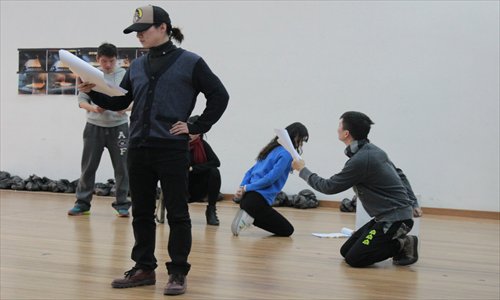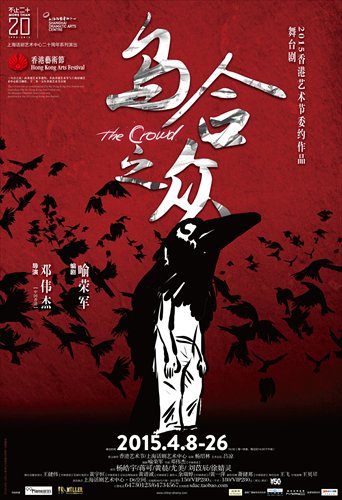Crowd work
Play inspired by work of Ibsen explores relationship between the individual and the masses
The Crowd is a new play by Shanghai-based writer Yu Rongjun. It is inspired by Henrik Johan Ibsen's 1882 play An Enemy of the People and the French social psychologist Gustave Le Bon's 1985 study of crowd psychology, The Crowd: A Study of the Popular Mind.
Commissioned by the 2015 Hong Kong Arts Festival and directed by Hong Kong theater director, Tang Wai-kit, Yu's The Crowd will premiere at the 2015 Hong Kong Arts Festival from March 27 to 29 in Hong Kong. It will then come to the Shanghai Dramatic Arts Centre from April 8 to 26.

Actors in a rehearsal of The Crowd
"Although titled The Crowd, the play mainly discusses the force of mass events, especially big social issues, and the effect they have on individuals," Yu said.
He is interested in how individuals behave when faced with the mainstream lifestyles and values of society, and how some people follow the crowd blindly, some become fanatics and some choose to stand in opposition to the masses.
The Crowd tells the story of one man's quest for vengeance against the person who caused the death of his mother during the Cultural Revolution (1966-76).
The hunt spans the 1960s to the present day, and takes place in Chongqing, Beijing, Shanghai and Hong Kong.
During its course, the protagonist continues to live his own life, getting married and having children.
He also experiences the big social changes and events that take place during the time span of the story, including the Cultural Revolution, the reform and opening-up, the Beijing Olympic Games, the Occupy Central movement in Hong Kong, and also the public square dancing that is currently very popular among middle-aged and elderly people.

A poster for the play Photos: Courtesy of Shanghai Dramatic Arts Centre
"Though the play covers many social issues, the playwright didn't set out to write a political play. It is rather about the relationship between the individual and the masses," Tang told the Global Times.
He said the play uses the story of revenge to link together different eras of China. It reflects on social movements, loss and alienation from the mainstream.
Tang said that the play's leading character is constantly burdened with a personal mission of his own, that is to seek the revenge that has become his life's quest.
"However, we don't want to shape an unrealistic character with great tragic heroism," said Tang. "We still believe he is an ordinary person who can lead a regular life, meeting other people and experiencing social changes and big crowd events, which must have an impact on him and his obsession with his own mission."
The fact the protagonist is married and has children ties him to reality.
When he finally gets the chance to exact his revenge, he is struck by fear, the knife shaking in his hands.
In one scene, he encounters a group of dancing elderly people. He unconsciously joins with them, imagining that when he reaches old age he will still be seeking vengeance.
Tang said there are many details in the play that are aimed at making the audience reflect on the role of an individual in a mass.
There are many characters in this play, but only six actors. Therefore, they have to jump from one character into another. Sometimes they play animals, such as a crow. Tang said that crows are social animals.
However, they are very smart, and will not hesitate to leave their group if they feel it is no longer able to ensure their survival.
Date: April 8 to 26, 7:30 pm from Tuesdays to Saturdays;
2 pm on Sundays; no show on Mondays
Venue: Shanghai Dramatic Arts Centre 上海话剧艺术中心
Address: 288 Anfu Road
安福路288号
Tickets: 150 yuan ($23.94), 180 yuan and 280 yuan
Call 6473-0123 for details